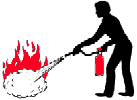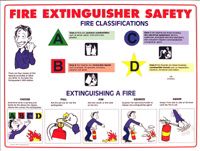 |
 |
| Table of Contents |

|

|
This document was originally designed to focus on fire situations in chemistry laboratories. While it continues to mention laboratories, the information contained herein is broadly applicable to almost all workplaces. Fire is the most common serious hazard that one faces in a typical chemistry laboratory. While proper procedure and training can minimize the chances of an accidental fire, you must still be prepared to deal with a fire emergency should it occur (Look here for a graphic example). This document teaches you the basics about fire extinguishers - proper types, how to use them, when and when not to use them as well as the proper procedures to follow should a fire occur. It is not a comprehensive guide; be sure to read the disclaimer given below. If your clothing is on fire (and the floor is not), STOP, DROP and ROLL on the ground to extinguish the flames. If you are within a few feet of a safety shower or fire blanket, you can use these instead, but do not try to make it "just down the hall" if you are on fire. If one of your coworkers catches fire and runs down the hallway in panic, tackle them and extinguish their clothing. |  Get fire extinguisher training posters, and more at SafetyEmporium.com. |
You can buy these in our on-line store, SafetyEmporium.com.
You may have other "clean agent" extinguishers besides CO2 (see next section), particularly if your workplace has sensitive electronic devices such as computers. Those who work with flammable metals may also have a specialized Class D dry powder extinguisher for use on fires (in a pinch, a bucket of dry sand will do, but you really should have a Class D unit if you work with such materials). Water-filled extinguishers are not acceptable for chemistry laboratory use. If you have a water-filled extinguisher in your laboratory, have it replaced immediately by contacting your campus or corporate Fire Marshal's office.
If you are not familiar with fire extinguishers and have not been trained in their use, DO NOT attempt to use them! If you work in a laboratory you should have received this training (it is usually a state or federal OSHA requirement); if not contact your supervisor immediately (TODAY....no kidding).
|
Now available: Our on-line store, SafetyEmporium.com, carries all kinds of fire extinguishers including foam, Halotron and those hard-to-find Class D models. Everything from small hand-held units to large wheeled units and fixed distribution systems. If you need 1 extinguisher or 1,000 we can meet your needs! |
Some fires may be a combination of these! Your fire extinguishers should have ABC ratings on them. These ratings are determined under ANSI/UL Standard 711 and look something like "3-A:40-B:C". Higher numbers mean more firefighting power. In this example, the extinguisher has a good firefighting capacity for Class A, B and C fires. NFPA has a brief description of UL 711 if you want to know more.
Here are some typical extinguishers and their uses:
When to use (or not use) Dry Chemical Extinguishers? Dry chemical extinguishers can be quite corrosive to metals such as aluminum and are also potentially abrasive. ABC extinguishers are much more corrosive than BC extinguishers because the ammonium phosphate agent can undergo hydrolysis to form phosphoric acid and because the molten agent flows into minute cracks. For this reason, dry chemical ABC extinguishers are not recommended for use on aircraft or electronics such as computers, MRI scanners, and scientific instruments. Boeing has stated in a service letter "Dry chemical extinguishers can cause extensive corrosion damage to airplane structure, electrical systems, and electronic equipment...Dry chemical fire extinguishers should only be used for airplane firefighting if there are no other extinguishers available and there is imminent danger to property or personnel." INCOMPATIBLES: ABC dry chemical extinguishing agents are incompatible with strong alkalis (bases), magnesium, strong oxidizers such as calcium hypochlorite (pool chlorine) and isocyanuric acids. BC dry chemical agents are incompatible with strong acids, lithium metal and sodium-potassium alloy (NaK), and monoammonium dihydrogen phosphate (also called "ammonium phosphate", NH4H2PO4). Mixing of fire fighting agents with incompatible materials can release toxic byproducts or pose other dangers. Alternative extinguishing agents should be used in areas where incompatible materials are likely to be used or encountered. For example, pool chemicals should be stored separate from other hazards and water extinguishers (see above) or carbon dioxide units should be provided.
|
Proper planning can avoid situations where you might have to make a choice between extinguisher types. Ensure that the extinguishers closest to your aircraft, computers, and pool chemicals are of an approriate type (if local fire codes permit) and that workers in those areas are trained on when and how to use them. It takes effective training to recognize if your computer or airplane is fully engulfed in flames or a person is in danger, then possible added damage from an ABC extinguisher is moot, but using one on pool chemicals is likely to increase the peril.
 | To get an idea for what could happen, take a look at this General Chemistry demonstration page that includes a QuickTime movie of a magnesium metal fire contained inside a block of solid CO2! |
Carbon dioxide extinguishers do not have pressure gauges because carbon dioxide is a condensable gas. Thus, pressure does not tell you how much agent remains in the cylinder. Instead, the extinguisher should have a tare (empty) weight stamped on it. To determine the amount of carbon dioxide remaining in the extinguisher, subtract the tare weight from the current weight.
 |
MAGNETIC FIELD WARNING If you work around extremely high field magnets such as magnetic resonance imaging (MRI) machines or nuclear magnetic resonance spectrometers (NMR's), you should only have non-magnetic fire extinguishers on hand. The magnetic field of an MRI or NMR machine is strong enough to make a steel cylinder fly across the room with lethal force. Our on-line store, Safety Emporium, carries 100% non-magnetic Cleanguard and water mist extinguishers (picture, right) for use in MRI/NMR facilities. |  |
Check out the potential fire hazards in your area. Is there an extinguisher available? Do you know how to operate it? Are your extinguishers suitable for the fires you may encounter? If not, you'll want to contact your campus or corporate Fire Marshal's office.
Typical small lab fires (in a hood or on a bench) can easily be controlled by a dry chemical (ABC) or CO2 extinguisher provided that you are properly trained.
 Mark the location of all your extinguishers with our vinyl or aluminum signs (as low as $5 each; English or Spanish). Get them now at SafetyEmporium.com. |
IF ANY OF THESE CONDITIONS HAVE NOT BEEN MET, DON'T FIGHT THE FIRE YOURSELF. CALL FOR HELP, PULL THE FIRE ALARM AND LEAVE THE AREA.
|  Learn more about Bourdon gauges at Safety Emporium. |
One more time: Recharge all extinguishers immediately after use regardless of how much they were used.
Federal, state or local government or other emergency management organizations who would like a PowerPoint version of the full training program so they can include their agency or local-specific material for noncommercial, educational or public safety use should contact Ed Harris through the Virginia RACES Training Page
If you can't find the file on your computer after downloading, use the Find feature of your computer operating system to search for the file name(s) listed above.
If you would like to take a course on the proper use of fire extinguishers (including some hands-on training) your campus or corporate Fire Marshal's office may be able to assist you. If not, try your local fire department's non-emergency phone number for more information.

[Top of this document] [ILPI Lab Safety Page]
This web page was last updated Sunday, June 12, 2016 and is copyright 1995-2025 by Rob Toreki. Send questions and comments to our Support Team. All rights reserved.